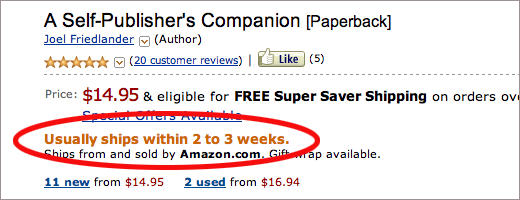For some years now many small publishers and self-publishers have been using a very effective strategy for distributing their books. This strategy has been widely written about and imitated. It was pioneered, as far as I know, by Aaron Shepard and Morris Rosenthal, both early proponents of print on demand distribution.
Here’s how the strategy works:
- Set up as a publisher with Lightning Source
- Set your discount to the shortest discount possible, 20%
- Have your book supplied to Amazon, where the vast majority of your sales will occur, at a discount that saves at least 20% off what you would have to pay Amazon otherwise.
On my standard book for pricing, here’s how this strategy plays out:
(A 200 page 6 x 9 paperback with no graphics or illustrations and simple formatting.)
Retail $15.00
Wholesale $12.00 ($15.00 less 20%, or $3.00 = $12.00)
Print cost $3.50
Net profit per copy sold $8.50 ($12.00 less $3.50)
This puts tremendous economic leverage in the hands of a self-publisher.
The Party’s Over
Now Amazon has changed the way they deal with books from Lightning Source and other print on demand suppliers—all except their own supplier, Amazon KDP.
Perhaps in an effort to trim costs, they have changed the way they drop ship books using the third party vendors, and instead using their own warehousing and fulfillment. Whatever the reason, many books from these vendors are now showing up with an availability of “Ships in 2 to 3 weeks.”

This is a real sales killer. When I heard about this move earlier this summer, I decided to leave A Self-Publisher’s Companion alone and see what happened.
And what happened was pretty bad. The book went to the dreaded “Ships in 2 to 3 weeks” and its sales rank took a nosedive as sales dried up.
A few weeks later, with the inventory apparently replenished, the book returned to a normal “In Stock. Ships from and sold by Amazon.” But it only lasted a few days until the listing started showing “Only 3 copies left” and eventually went back to “Ships in 2 to 3 weeks.”
Solutions
As the most vocal proponent of the short discount strategy, Aaron Shepard admitted the world had changed, and came up with a “Plan B” to help other publishers facing this challenge.
For about the past decade, the most profitable approach to selling books on Amazon has been to distribute through Lightning Source at a short discount—a strategy I helped introduce in my book Aiming at Amazon and elaborated on in its companion volume, POD for Profit. But now it looks like the days of that strategy may have come to an end. For those of us currently working with Lightning, the question is, what will replace that approach? In other words, what is Plan B?—Aaron Shepard’s Publishing Blog
You can read the whole of Plan B by following the link, but part of the strategy is to make your book available at both Amazon KDP and Lightning Source—with the same ISBN—to take advantage of both companies’ strengths.
This is what I’m now recommending to my clients who are at Lightning Source. Others I’m sending directly to Amazon KDP.
What’s the impact of this difference? At Amazon KDP the “shortest” discount you can set is 40%. Here’s how it works out:
Retail $15.00
Wholesale $9.00 ($15.00 less 40%, or $6.00 = $9.00)
Print cost $3.50
Net profit per copy sold $5.50 ($9.00 less $3.50)
In other words, for every copy you sell at 40% discount instead of 20% discount, you will make $3.00 less. If you sell 100 books, you’ve just lost $300.
Now, it never feels good to lose control of a process that’s at the heart of your business model. But remember that publishing is a lot more than a specific margin per book.
In fact this is a great reminder for all of us that the form we use to send our work, our ideas, our stories and our passions into the world is not the crucial part of our business. What’s crucial—and what people pay for—is the value we create for our readers.
It’s interesting to me that Shepard, in the same article, now recommends new self-publishers skip print books entirely until they’ve tested their works in e-book form.
Let’s be nimble. As the world of books continues to twist and turn into new and startling shapes, let’s keep adapting, coming up with whatever Plan Bs, Plan Cs, Plan Ds we need to in order to continue what we started when we first decided to publish our work.


